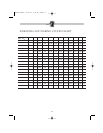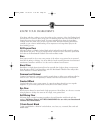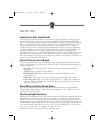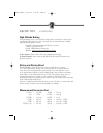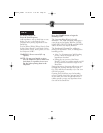
17
KNOW YOUR INGREDIENTS (CONTINUED)
Vital Wheat Gluten
Gluten is manufactured from wheat flour that has been treated to remove nearly all of
the starch, which leaves a very high protein content. (Gluten is the protein in the wheat
that makes the dough elastic.) Gluten is available at most health food stores and in the
baking aisle in many markets. It is sometimes used in small portions with dense, low-
gluten flours (such as whole wheat) to increase volume and lighten texture.
Whole Wheat Flour
Whole wheat flour is milled from the entire wheat kernel, which contains the bran and
germ. This high fiber flour is richer in nutrients than all-purpose or bread flour. Breads
made with this flour are usually smaller and heavier than white loaves. Many recipes mix
whole wheat flour with bread flour or vital wheat gluten to produce a high, light-textured
bread.
Flour Storage
Keep flour in a secure, airtight container. Keep rye and whole wheat flours stored in a
refrigerator, freezer or a cool area to prevent them from becoming rancid. Allow flour to
come to room temperature before using.
NOTE: Flours, while visibly similar, can be very different by virtue of how they were
ground, milled, stored, etc. You may have to experiment with different brands of
flour to help you make the perfect loaf. See RECIPE TIPS Section of this
Instruction Manual to assist with these experiments.
Yeast
Active yeast, through a fermentation process, produces carbon dioxide gas necessary to
make bread rise. Yeast feeds on carbohydrates in sugar and flour to produce this gas.
Three different types of yeast are available: fresh (cake), active dry and quick-acting.
Quick or rapid rise or bread machine yeasts are quick-acting.
Fresh (cake) yeast is NOT
RECOMMENDED for use with your
Breadman® Ultimate Plus Bread Maker.
Ensure your yeast is fresh by checking its expiration date. Once a package or jar of yeast is
opened, it is important that the remaining contents be immediately resealed and
refrigerated or frozen for future use. Often dough that fails to rise is due to stale yeast.
The following test can be used to determine if your yeast is stale and inactive.
1. Place 1/2 cup of hot (110ºF-115ºF/43ºC-46ºC) water into a liquid
measuring cup.
2. Stir 1 teaspoon of sugar into the water and then sprinkle 2 teaspoons of yeast
over the surface.
3. Allow mixture to sit for 10 minutes undisturbed.
4. The mixture should foam and rise to the 1 cup mark. If this does not occur,
discard this yeast and purchase fresh yeast.
TR2500_FINAL 10/14/05 3:14 PM Page 23





